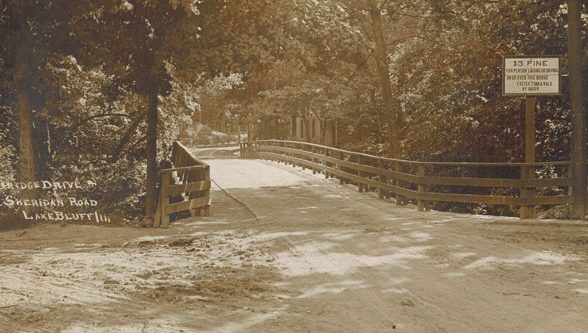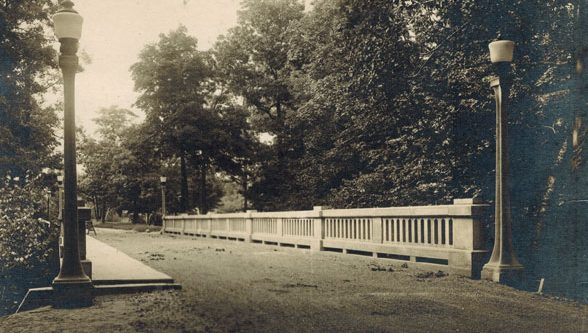The Moffett Bridge that spans the ravine at Sylvan Road and Ravine Avenue in Lake Bluff previously was called the Harris Bridge, and 100-plus years ago it caused a major rift between Lake Forest and Lake Bluff.
In 1918 while World War 1 and the deadly influenza pandemic of 1918 were in the national news, just look at headlines from local newspapers that summer:
“The North Shore Trembles with Palsied Bridge”
“Indignation High in Lake Forest as Result of Actions in Lake Bluff”
“Lake Forest People Up in Arms Over (Lake Bluff’s) Attitude Towards Naval Station”
Here’s what the drama was all about: In the summer of 1918, for two days every week, Lake Bluff closed access to the bridge on what’s now known as Moffett Road. Back then the bridge was called Harris Bridge and the road was known as Sheridan Road, as it was part of the “pleasure road” that stretched from Chicago to the Wisconsin border.
The closing of the Harris Bridge prompted Lake Forest residents to accuse the Village of discriminating against them and other drivers who were trying to get to the Great Lakes Naval Station. A local newspaper reported on August 2, 1918, that “As a result of this practice, autoists coming from Chicago along Sheridan Road are compelled to turn around and go way back through Lake Forest and then skip over to the Green Bay Road west of Lake Bluff.”
Lake Bluff officials said there was sound reason for gating the bridge, as it was a rickety, wooden structure left over from the previous century’s Camp Meeting days and could not sustain the extra traffic traveling to the Naval Station’s visiting days on Wednesdays and Sundays. Finances also were a problem. One news reporter noted that “the Village’s till was weaker than the bridge.”
Speaking of Sheridan Road, did you note that Moffett Road was called Sheridan Road when this drama occurred? Perhaps you’ve wondered why there are so many “Sheridan” roads in Lake Bluff (Sheridan Road, E. Sheridan Road, W. Sheridan Road, E. Sheridan Place and W. Sheridan Place), or why Sheridan Road takes a sharp detour to the west in Lake Bluff from Lake Forest? It is because of the bridge fiasco from 1918.
The Naval Station’s commander then was Captain William Moffett (later Admiral Moffett). He lived off-base in Lake Forest and knew first hand how rough the bridge was because he drove over it to get to work every day. Captain Moffett had Navy engineers test the bridge, and they determined “the city fathers of Lake Bluff had not feared enough.”
A new bridge was needed, and fast.
It was decided that Lake Bluff would purchase supplies, including 50,000 feet of lumber plus concrete and steel, to build a new bridge over the ravine. The Naval Station provided sailors for manpower, and the bridge was built in 30 days.
Wrote one newspaper at the time: “Structure Over Ravine at Lake Bluff Rises Almost If By Magic Touch.”
A little more than magic was needed, however. Captain Moffett may have advanced $5,000 to the Village so that the work could go on immediately. He was a big friend to the Village in other ways as well. During the winter storm of 1918, he had sailors shovel the Village out from several feet of snow.
While he was commander at Great Lakes, Captain Moffett established an aviator training program. He was later appointed head of Naval Aeronautics and was the leader for Navy air craft after WWI. A proponent of aircraft carriers known as dirigibles (aka blimps), he died when the USS Akron, then the largest dirigible in the world, crashed in the Atlantic Ocean in 1933.
But Captain Moffett’s name lives on in Lake Bluff to this day. In 1922, Village trustees changed the name of Sheridan Road to Moffett Road. To do this, they had to shuffle a bunch of other street names and add the east-west stretch that is East Sheridan Road. Other juggling: What we now call Sheridan Road in Lake Bluff back then was known as Waukegan Road, and what we now call Waukegan Road was Corduroy Road, because the earlier road’s wooden structure resembled ridges in corduroy fabric.
Even the Harris Bridge got a new name. Not surprisingly, it’s the Moffett Bridge.

